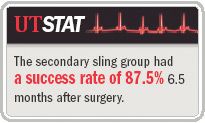Article
Second sling after failure found efficacious, safe
Author(s):
Atlanta-Minimally invasive slings can work in women with stress urinary incontinence, even after a sling has failed. A key to success may be a higher presurgical Valsalva leak-point pressure.
Atlanta-Minimally invasive slings can work in women with stress urinary incontinence, even after a sling has failed. A key to success may be a higher presurgical Valsalva leak-point pressure.
That was the conclusion of investigators at Duke University's Female Urology and Urogynecology Clinic in Durham, NC, who presented their results here at the AUA annual meeting. They analyzed the results of minimally invasive pubovaginal slings in 214 women, 44 of whom had a second sling procedure.

Primary, secondary results similar
There was no significant difference in cure rates between the primary sling and secondary sling groups. At an average follow-up of 6.5 months, the success rate was 86.8% in the former and 87.5% in the latter, with cure defined as no pad use or only one pad per day for protection. In addition, there were no significant differences in complications, which included retention requiring urethrolysis in one patient and intraoperative cystotomy in three patients who had secondary procedures.
"I suspect if we followed these patients farther down the road, we might start to see a slight separation between the two groups, but I think what we've shown is that the minimally invasive sling is a very viable, safe, efficacious procedure to do in these women who've had failures," Dr. Borawski told Urology Times.
In women who had secondary slings, the type of sling had no statistically significant bearing on success, even though there was a slight difference favoring the synthetic sling. The researchers suspected that, ultimately, follow-up might favor the synthetic sling.
Leak-point pressures, however, did seem to predict failure for secondary procedures. In fact, all of the women who had secondary procedures fail had leak-point pressures of 30 cm H2O or less. The cure rate in that group was only 61.5%.
"We haven't identified the best treatment for women with a low Valsalva leak point pressure," said Dr. Borawski. "But we wanted to show that, although we had less than optimal results in this group, it still worked in over half the women."
Why did the sling procedures fail in the first place? The team could only guess, but the original sling may not have been in the correct position, the sling material may have played a role, or the tension wasn't enough for coaptation. The surgeons did make their secondary slings tighter, and they prefer synthetic slings. Careful dissection and proper placement are also important, Dr. Borawski said.
This is a small group of patients, she said, so randomized trials need to be designed to determine which presurgical factors predict which secondary procedures are best for different patients with stress urinary incontinence.
















